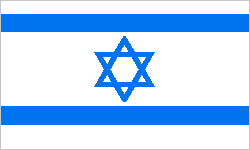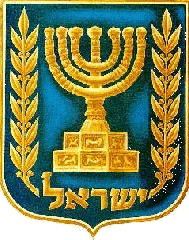The Flag of Israel
In 1948, after nearly two thousand years of exile, the State of Israel was reestablished as the Jewish homeland.

The Blue and White flag has two blue stripes and a Star of David in it.
The new flag of the modern state was unfurled at the United Nation in 1949. The flag has been a symbol of the proud return of the Jewish nation to its homeland.
How the Israeli Flag Was Chosen?
David Wolffsohn, who attended the First Zionist Congress in 1897, tells the story of the birth of the Israeli flag:
“At the request of our leader Herzl, I came to Basle to make preparations for the Zionist Congress. Among many other problems that occupied me then was one, which contained something of the essence of the Jewish problem. What flag would we hang in the Congress Hall? Then an idea struck me. We have a flag — and it is blue and white. The Tallit (prayer shawl) with which we wrap ourselves when we pray: that is our symbol. Let us take this Tallit from its bag and unroll it before the eyes of Israel and the eyes of all nations. So I ordered a blue and white flag with the Shield of David painted upon it. That is how the national flag, which flew over Congress Hall, came into being. The blue stripes above and below the Magen David remind us of the Tallit. When we see the Israeli flag, we remember the faith and the prayers of the many generations of Jews who longed for the return to their homeland.”
Magen David
The Magen David is a traditional symbol of Judaism. The star is made up of two triangles, one right-side up and the  other upside down. One of them points upward toward all that is spiritual and holy. The other one points downward — toward all that is earthly and secular. By leading a life of Torah and mitzvot, the Jew strives to bring together the worlds of the spiritual and the earthly, the worlds of the holy and the secular. Legend tells us that David the king of Israel adorned his shield with this six-pointed star, thus the star is named the Magen David.
other upside down. One of them points upward toward all that is spiritual and holy. The other one points downward — toward all that is earthly and secular. By leading a life of Torah and mitzvot, the Jew strives to bring together the worlds of the spiritual and the earthly, the worlds of the holy and the secular. Legend tells us that David the king of Israel adorned his shield with this six-pointed star, thus the star is named the Magen David.
Israel Seal
The Israeli seal reminds us of a very sad story that happened a long time ago. In the year of 70 CE, a Roman general, named Titus, captured the city of Jerusalem, and his armies savagely destroyed the Holy Temple. They seized the golden Temple Menorah. To shame their unfortunate Jewish prisoners, Roman soldiers forced them to parade in chains through the streets of Rome carrying the captured Temple Menorah. The Romans felt so proud of this triumph that they pictured the event on a monument called the Arch of Titus. Today, the Arch of Titus still stands in Rome, and the picture of the Menorah can still be seen. To the Romans, the story celebrated might and triumph, but to the Jewish people the story told the worst humiliation: the loss of independence in our homeland.
golden Temple Menorah. To shame their unfortunate Jewish prisoners, Roman soldiers forced them to parade in chains through the streets of Rome carrying the captured Temple Menorah. The Romans felt so proud of this triumph that they pictured the event on a monument called the Arch of Titus. Today, the Arch of Titus still stands in Rome, and the picture of the Menorah can still be seen. To the Romans, the story celebrated might and triumph, but to the Jewish people the story told the worst humiliation: the loss of independence in our homeland.
After almost two thousand years and much agony and bloodshed, the modern State of Israel reestablished the Jewish Homeland. Although the Temple and the Menorah were not actually rebuilt, The Jews felt that in a symbolic way, the Menorah had been saved from its ancient disgrace and restored to its original glory. The Jewish dream of independence and return has finally come true. Click here for a coloring page of Israel’s Seal.
The Olive Branches
The prophet Zechariah, who lived in the sixth century, had a vision. He saw a golden seven branched menorah flanked by two olive trees. Our Rabbis interpreted this vision to mean that the Temple and the State of Israel would someday be restored to their former glory. Also, olive branches are symbols of peace.
HaTikva
HaTikva means “the hope”. It is the national anthem of Israel and expresses the hope of Jews everywhere that we can be free to worship in our own land and its capital, Jerusalem. Click here for the music of HaTikva.

